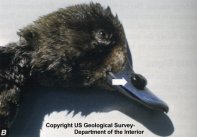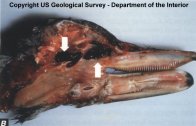| Nasal Leeches of Waterfowl |
|
| |
| Causative Agent |
-
A leech of the genus Theromyzon that feeds directly on blood
from the nasal passages, trachea and
mucous
membranes
of the eyes of migratory waterfowl.
-
Other species of leeches feed on other exposed surfaces of
waterfowl.
|
| Images |
|
Click on images to enlarge. |
 |
 |
|
Nasal leeches are often visible as they infest external nasal
passages. |
Nasal leeches also infest
the nasal sinuses. |
|
| Distribution |
|
Geographic: |
-
Common on birds north of the 30th parallel and in western
North America.
|
|
Seasonality: |
-
Peak infestations occur during the spring and summer months when leeches
are actively seeking potential hosts and reproducing.
-
Winter slows the metabolic rate and activity of leeches.
|
|
| Hosts |
-
Many aquatic birds are affected; commonly dabbling ducks (e.g.,
mallard, teal, wigeon, northern shoveler, etc.) and swans.
|
|
| Signs and Symptoms |
-
Leeches are 10-45 mm long when fully engorged, and are dark yellow to
olive in color.
-
Free-living leeches are green with patterns of spots on the top surface.
-
Birds with leeches protruding from the nostrils or attached to the
mucous membranes of the eyes are easily recognized at a distance with binoculars.
-
Leeches may become so engorged with blood that they resemble sacks of
blood.
-
Infected birds may vigorously shake their heads, scratching at their
bills with their feet, or sneeze in an attempt to dislodge leeches.
-
Leeches lodged in the nostrils and respiratory tract can cause labored
breathing and gaping (breathing with an open bill) similar to that
seen in birds affected by
Aspergillus infection.
-
Feeding leeches can lead to
extensive damage and
inflammation of the lining of the nasal
cavity.
-
Severe infestations of the
eye can result in temporary blindness.
-
Leeches protruding from the
nostrils or attached to the eyes can be removed with forceps.
|
| Meat Edible? |
-
Meat is edible but, if considerable blood-loss has occurred from leech
infestation, the quality of meat may be decreased.
|
| Human Health Concerns and
Risk Reduction |
-
Theromyzon
leeches feed exclusively on
birds and are not considered a threat to humans.
|
| Samples for Diagnosis |
-
Nasal leeches often cannot be observed externally, so submitting the
entire carcass is warranted.
-
Nasal leeches will depart from a dead bird or may move to other areas of
the bird, making them difficult to see. Leeches found on the carcass
should be submitted as well for identification.
-
Leeches can be shipped live in pond water and maintained for several
months in a refrigerator.
|
| Similar Diseases |
-
Similar breathing
difficulty is observed in birds with
aspergillosis
|
| Further Reading |
-
Tuggle B.N. 2001. Nasal leeches. Pp. 245-248 in
Field Manual of Wildlife Diseases: General Field Procedures and Diseases
of Birds. M. Friend, J.C. Franson (Tech. eds.), E.A. Ciganovich
(ed.). Biological Resources Division Information and Technology
Report 1999-001. U.S. Department of the
Interior and U.S. Geological Survey. Washington, DC. (Chapter
in PDF Format)
|
|
|

